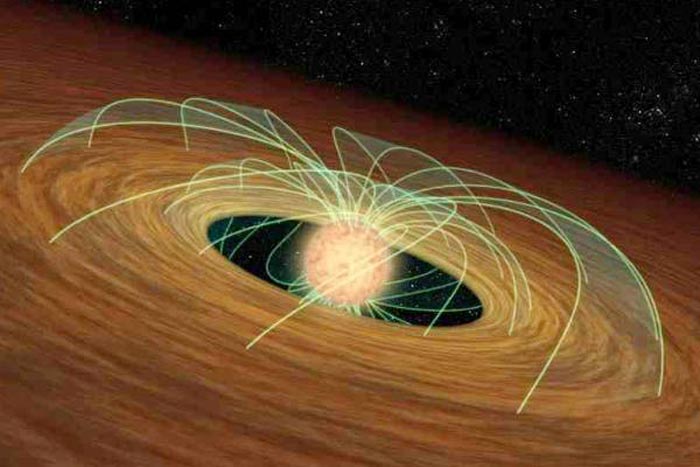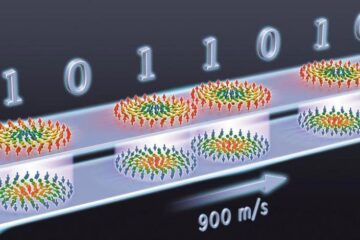Why does Mercury have a big iron core?

The magnetic field of the early Sun. The start of the solar system sees the initiation of the Sun's dynamo, which creates a strong magnetic field (green lines), that pulls magnetic, iron--rich particles towards the Sun in the planetary accretion disk.
Credit: NASA/JPL-Caltech
Scientists from Tohoku University and the University of Maryland have pinpointed the strong magnetic field of the early sun as the reason behind the radial variation of rock and metal in rocky planets’ cores. This magnetic field, which pulled small iron grains inward, explains Mercury’s big iron core and why Mars has so little iron in its core.
The details of their research were published in the journal Progress in Earth and Planetary Science on July 5, 2021.
Planets have iron cores surrounded by a rocky shell, mostly made up of mantle and a thin skin of crust. The four inner planets of our Solar System, Mercury, Venus, Earth, and Mars have their own distinctive size and density. These differences have long since puzzled scientists.
Mercury has a metallic core making up about 3/4 of its mass, with the remaining 1/4 being a rocky silicate shell. The cores of Earth and Venus possess a metallic core of only 1/3 of their mass, with the rest being rock. Mars has a measly core comprising only 1/4 of its mass.
These radical changes in metal content offer clues about what controlled the distribution of raw materials in the early formation of the solar system.
During this period, swirling gas and dust cloud drew matter into the Solar System’s center, thus forming the Sun. The rapid delivery to the center caused many collisions and heated the inner region of the Solar System. When the Sun was big enough to have its own internal gravity, it caused its proton-rich core to ignite its nuclear fuel, brightly turning on the Sun. Following this, the Sun’s core began convecting, creating a dynamo generating a strong magnetic field.
The high temperatures of the inner Solar System turned elements into a vapor state. As the element cloud cooled down it rained out mineral compounds. Evidence from primitive meteorites reveals the compounds precipitated were either silicates or metals. The sun’s magnetic field pulled the metal particles inwards.
The composition of inner rocky planets is remarkably similar to primitive meteorites. Also known as chondrites, these meteorites are jumbled mixtures of rock and metal in different proportions. Unlike rocky planets, they do not have cores.
The raw materials making up the rocky planets are just four unevenly distributed elements: oxygen, iron, magnesium, and silicon. This represents about 93% of a rocky planet’s mass. Around 70% of that is equal measure oxygen and iron, whilst the rest consists of equal measure magnesium and silicon.
“Planetary cores are a big deal,” proclaims coauthor of the study Bill McDonough. “They control where elements end up in the planet.” McDonough points to the Earth’s abundance of the nutrient phosphorus concentrated in its core as an example. “Planetary habitability also depends upon the size and compositions of its core in addition to the lifetime of its dynamo.”
The core’s dynamo generates a magnetic shield that protects us from cancer-causing cosmic rays. Once Mars lost its core dynamo, its surface water disappeared quickly thereafter.
Early on in Solar System formation, a cloudy disc of gas and dust surrounded the Sun and planets, serving as a conduit for the Sun’s magnetic field. The strength of the magnetic field weakened as it got further away from the Sun. Mercury formed in the prime location – close to where the Sun’s magnetic field was strongest, thus explaining its large iron core.
All latest news from the category: Physics and Astronomy
This area deals with the fundamental laws and building blocks of nature and how they interact, the properties and the behavior of matter, and research into space and time and their structures.
innovations-report provides in-depth reports and articles on subjects such as astrophysics, laser technologies, nuclear, quantum, particle and solid-state physics, nanotechnologies, planetary research and findings (Mars, Venus) and developments related to the Hubble Telescope.
Newest articles

Properties of new materials for microchips
… can now be measured well. Reseachers of Delft University of Technology demonstrated measuring performance properties of ultrathin silicon membranes. Making ever smaller and more powerful chips requires new ultrathin…

Floating solar’s potential
… to support sustainable development by addressing climate, water, and energy goals holistically. A new study published this week in Nature Energy raises the potential for floating solar photovoltaics (FPV)…

Skyrmions move at record speeds
… a step towards the computing of the future. An international research team led by scientists from the CNRS1 has discovered that the magnetic nanobubbles2 known as skyrmions can be…





















